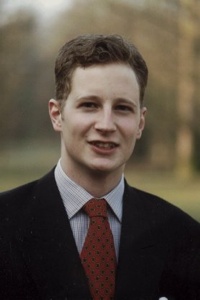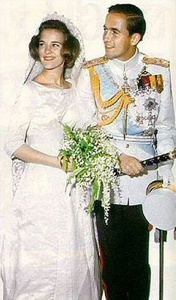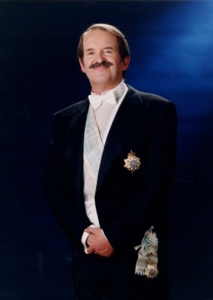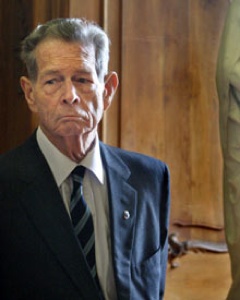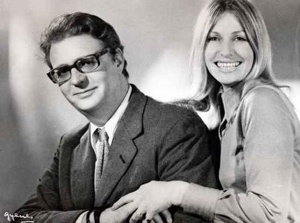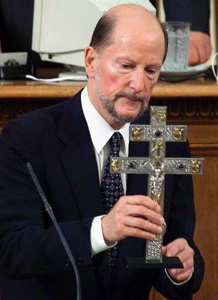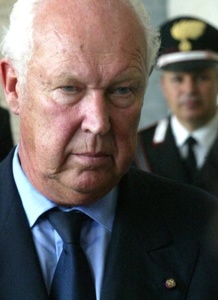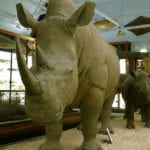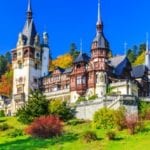 Weird Stuff
Weird Stuff  Weird Stuff
Weird Stuff  Our World
Our World 10 Ways Your Christmas Tree Is More Lit Than You Think
 Movies and TV
Movies and TV The 10 Coolest Stars to Set Sail on The Love Boat
 History
History 10 Things You Didn’t Know About the American National Anthem
 Technology
Technology Top 10 Everyday Tech Buzzwords That Hide a Darker Past
 Humans
Humans 10 Everyday Human Behaviors That Are Actually Survival Instincts
 Animals
Animals 10 Animals That Humiliated and Harmed Historical Leaders
 History
History 10 Most Influential Protests in Modern History
 Creepy
Creepy 10 More Representations of Death from Myth, Legend, and Folktale
 Technology
Technology 10 Scientific Breakthroughs of 2025 That’ll Change Everything
 Weird Stuff
Weird Stuff Ten Bizarre Facts About The Doge Meme
 Our World
Our World 10 Ways Your Christmas Tree Is More Lit Than You Think
 Movies and TV
Movies and TV The 10 Coolest Stars to Set Sail on The Love Boat
Who's Behind Listverse?

Jamie Frater
Head Editor
Jamie founded Listverse due to an insatiable desire to share fascinating, obscure, and bizarre facts. He has been a guest speaker on numerous national radio and television stations and is a five time published author.
More About Us History
History 10 Things You Didn’t Know About the American National Anthem
 Technology
Technology Top 10 Everyday Tech Buzzwords That Hide a Darker Past
 Humans
Humans 10 Everyday Human Behaviors That Are Actually Survival Instincts
 Animals
Animals 10 Animals That Humiliated and Harmed Historical Leaders
 History
History 10 Most Influential Protests in Modern History
 Creepy
Creepy 10 More Representations of Death from Myth, Legend, and Folktale
 Technology
Technology 10 Scientific Breakthroughs of 2025 That’ll Change Everything
Top 10 Pretenders to the Thrones of Europe
Revolution filled the air at the end of the 1800s and beginning of the 1900s, destroying many ancient monarchies. The majority of the revolting nations replaced their thrones with communist governments. You may be surprised to know that while democracy (now the main political system of most of the nations below) plods on from day to day, the heads of the Royal families deposed, continue to use their titles, claim their thrones, and interact with other ex-royals on a regular basis. This is a list of the top 10 pretenders. These are the men and women who would be Kings, Queens, Emperors, and Empresses if their thrones were restored today.
1. The Throne of Germany and Prussia Georg Friedrich, Prince of Prussia
George Friedrich (born in 1976) is the great-great-grandson of William II (Emperor from 1888 to 1918) and is the head of the House of Hohenzollern. He was schooled in Germany but completed his education in Perth, Scotland, and went on to study Business Economics at the Freiberg University of Mining and Technology. He succeeded his grandfather, Prince Louis Ferdinand I of Prussia as head of the House of Hohenzollern in 1994. As head of the house he is occasionally styled His Royal Highness The Prince of Prussia, or alternatively His Imperial and Royal Highness The Prince of Prussia.
The law of Germany does not recognize princely titles, but German civil law these titles are considered to be a part of a person’s surname. Two of his uncles took him to court over his position as head of the House of Hohenzollern, and after many cases, the Federal Constitutional Court of Germany stated that Georg Friedrich was the full heir of his grandfather and that the two uncles were entitled to a small portion of the Prussian inheritance. In an interview with Vanity Fair magazine, Georg Friedrich said: “The German people should think about bringing back the monarchy, I am sure it will happen.”
Read about one of history’s most determined noblemen in The Perfect Prince: Truth and Deception in Renaissance Europe at Amazon.com!
2. The Throne of France Louis Alphonse, Duke of Anjou
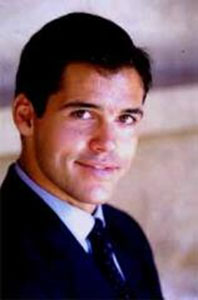
If the French throne were restored, Louis Alphonse would become King Louis XX of France. Lous was born in 1974 in Madrid. He is a great-grandson of King Alfonso XIII of Spain and first cousin once removed of King Juan Carlos I of Spain. He is also a great-grandson of Francisco Franco. His supporters usually call themselves legitimists, one of two claimant parties to the extinct throne of France. On February 7, 1984 Louis Alphonse’s older brother Francisco died as the result of a car crash. From then on, Louis Alphonse was considered to be the heir apparent to his father, according to the legitimists.
On January 30, 1989 his father died in a skiing accident in Beaver Creek, Colorado. Louis Alphonse became “chef de la Maison de Bourbon” (Head of the French Royal House) and took the title Duke of Anjou. He is considered the pretender to the French throne. Louis Alphonse and his wife Margarita had their first child, a daughter, named Eugenia on March 5, 2007 at Mount Sinai Medical Center, Miami, Florida. She was baptised at the Papal Nunciature in Paris in June 2007. French legitimists recognise her as Princess Eugenie of Bourbon; in Spain her name is Doña Eugenia de Borbón y Vargas. Louis Alphonse is recognized as His Royal Highness by the French Minister of Justice.
3. The Throne of Russia Grand Duchess Maria Vladimirovna
Maria Vladimirovna is regarded by Russian monarchists as the Head of the Imperial Family of Russia and Titular Empress and Autocrat of All the Russias since 1992. Throughout her life she has used as her title and style of pretension Her Imperial Highness Grand Duchess Maria Vladimirovna of Russia. She was born in 1953, the daughter of Grand Duke Vladimir Cyrillovich of Russia, considered by some as the Head of the Imperial Family of Russia and Titular Emperor of Russia.
Maria studied Russian and Russian history at Oxford University and lives in France and Spain. Her son, George (Grand Duke George Mikhailovich of Russia), was born and baptized in Madrid in 1981. His Godfather is King Constantine II of Greece (pretender since 1973). Other important people who attended the baptism were King Juan Carlos and Queen Sofia of Spain, King Simeon II and Queen Margarita of Bulgaria (pretender since 1946), and other dignitaries from the Russian royal family. Maria Vladimirovna is 109th in line of succession to the British Throne.
4. The Throne of Greece King Constantine II
Constantine of Greece, formerly Constantine II, King of the Hellenes (born June 2, 1940) was King of Greece from 1964 until the abolition of the monarchy by the Greek military junta on June 1, 1973. During the Metapolitefsi, the transitional period following the fall of the Junta, the matter of his restoration to the throne was set on the Greek plebiscite, 1974 (December 13, 1974) and the results confirmed his deposition. He never announced his abdication. However, unable to overthrow the government by royal edict, as in 1965, he never openly questioned the outcome and asked his supporters to respect the outcome (over two thirds of the electorate voted for the abolition of the monarchy).
He has lived in exile since 1967. Also called by supporters as King Konstantinos XIII, extending the line succession of the Byzantine empire, from the last Byzantine emperor Constantine XI. Until 1994, Constantine’s official Greek passport identified him as “Constantine, former king of the Hellenes.” A law passed in 1994 stripped him of his Greek citizenship, passport, and property. The law stated that Constantine could not be granted a Greek passport unless he adopted a surname. Constantine has since refused to comply. Constantine continues to use the title “King Constantine,” although he no longer uses “Constantine, King of the Hellenes”.
5. The Throne of Austria-Hungary Crown Prince Otto
Otto, Crown Prince of Austria or Otto von Habsburg (born 20 November 1912 as Archduke Franz Joseph Otto Robert Maria Anton Karl Max Heinrich Sixtus Xaver Felix Renatus Ludwig Gaetan Pius Ignatius of Austria) is the current head of the Habsburg family and the eldest son of Karl of Austria, the last Emperor of Austria and last King of Hungary, and his wife, Zita of Bourbon-Parma. Otto lives in Bavaria in Germany, and is a German, Austrian, Croatian, and Hungarian citizen. Although his official name in Germany is Otto von Habsburg, he is referred to as Otto Habsburg-Lothringen by Austrian authorities. He is also often known as Archduke Otto of Austria, Crown Prince Otto of Austria, and in Hungary, simply as Habsburg Ottó.
Otto is alleged to have struck fellow MEP (Member of the European Parliament) Ian Paisley. When Pope John Paul II gave a speech to the European Parliament in 1988, Paisley shouted at the Pope, “I renounce you as the Antichrist!” and held up a poster reading “Pope John Paul II Antichrist”, whereupon he was excluded from the session and expelled from the room by other MEPs. Otto von Habsburg used to be a chain smoker until his marriage, smoking up to hundred cigarettes a day. Today he does not smoke at all, with the exception of one day in the year: the World No Tobacco Day.
Get free shipping, thousands of movies, and millions of streaming songs with a FREE trial of Amazon Prime at Amazon.com!
6. The Throne of Portugal Duarte Pio, Duke of Braganza
Duarte Pio is the 24th Duke of Braganza (Portuguese Duque de Bragança) and the pretender to the throne of Portugal. He was born in Berne, Switzerland, the eldest son of Duarte Nuno, Duke of Braganza and his wife Maria Francisca de Orleans e Bragança, princess of Brazil. At the time of his birth Duarte’s family was banned from entering Portugal by the laws of exile of December 19, 1834 and October 15, 1910. Although Portugal had been a republic since 1910, Duarte’s parents sought to assure the child’s eventual rights of succession to the Portuguese throne, which required Portuguese nationality, by arranging for his birth to take place in the Portuguese embassy in Berne. Duarte’s godparents were Pope Pius XII and Queen Amélie of Portugal, the mother of Manuel II, the last reigning king of Portugal.
On May 27, 1950 the National Assembly repealed the laws of exile of December 19, 1834 and October 15, 1910. In 1951 Duarte visited Portugal for the first time accompanied by his aunt the Infanta Filippa. In 1952 he moved to Portugal permanently with his parents and brothers. On May 13, 1995, Duarte married Isabel de Herédia, a Portuguese businesswoman. This was the first marriage of a member of the Portuguese royal family to take place in Portugal since the marriage of King Luís I in 1862. The ceremony was celebrated in the Monastery of Jerónimos in Lisbon and presided over by Cardinal António Ribeiro, Patriarch of Lisbon. It was attended by the principal Portuguese political figures, including the President of the Republic Mário Soares, the President of the Assembly of the Republic, and the Prime Minister Aníbal Cavaco Silva. Also present were representatives of most European royal houses.
7. The Throne of Romania King Michael
Michael I, King of the Romanians, Prince of Hohenzollern (born October 25, 1921), reigned as King of the Romanians from July 20, 1927 to June 8, 1930, and again from September 6, 1940 until forced to abdicate by the Communists on December 30, 1947. A great-great-grandson of Queen Victoria and a third cousin of Queen Elizabeth II, he is one of the last surviving heads of state from World War II, the other being Simeon II of Bulgaria. In November 1947 Michael traveled to London for the wedding of the future Queen Elizabeth II, occasion during which he met Princess Anne of Bourbon-Parma, who was to become his wife. He returned to Romania “at the express advice of Winston Churchill,” who “is said to have counseled Michael, ‘above all things, a king must be courageous.’”
After his return to Romania, Michael was forced to abdicate, on December 30, 1947. The Communists announced the abolition of the monarchy and its replacement by a people’s republic and broadcasted the King’s pre-recorded radio proclamation of his own abdication. On January 3, 1948 Michael was forced to leave the country. In March 1948 he denounced his abdication as forced and illegal. Time magazine alleged that it took Michael over two months to denounce his abdication because “he had been negotiating with the Communists for the salvage of some of his Romanian properties”.
8. The Throne of Albania Crown Prince Leka
Leka, Crown Prince of Albania (Leka I Zogu), (born April 5, 1939, the Royal Palace, Tirana) is the only son of King Zog I and Queen Geraldine. He was christened Crown Prince Skander at birth. He is the pretender to the Albanian throne. He is known, and is often referred to by many people including monarchists and members of the media, as King Leka I. King Zog I was forced into exile only two days after the birth of Leka and soon officially replaced on the throne of Albania by Victor Emmanuel III of Italy — an action the King of Italy would later plead personal forgiveness for. Count Ciano, the Italian Foreign Minister, arrived soon after the invasion; on searching the Palace in Tirana found the ‘labour room’ in the Queen’s suite; seeing a pile of linen on the floor, stained by the afterbirth, he kicked it across the room. “The cub has escaped!” he said.
Leka was educated at English schools in Egypt and at Aiglon College, Villars-sur-Ollon, Switzerland. Fluent in seven languages he also studied economics at Sorbonne and passed out of Sandhurst Military Academy in England. Following this he was commissioned as a Second Lieutenant in the British Army. He has since reinforced the family fortune with successful business deals in commodities. Leka became heir apparent of the abolished throne on April 5, 1957. At the death of King Zog I in 1961, Leka was proclaimed King of the Albanians by the Albanian National Assembly-in-Exile. In 1975, Leka married Australian citizen and former teacher Susan Cullen-Ward in Biarritz. They were married in a civil ceremony in the Hôtel de Ville, Biarritz. The wedding reception, at a five-star Toledo Roadhouse, was attended by members of other exiled royal families, loyal Albanians and Spanish friends, who toasted “Long live the King”.
9. The Throne of Bulgaria Tsar Simeon II
Simeon II of Bulgaria or Simeon of Saxe-Coburg and Gotha (born June 16, 1937) was head of state as the Tsar of Bulgaria, Tsar Simeon II, from 1943 to 1946. He served as Prime Minister of Bulgaria from 2001 until August 2005. His legal name as a bulgarian citizen, and the one he uses as a politician, is Simeon Borisov Sakskoburggotski. He is still mostly referred to as Tsar Simeon II, or simply “The King”.
Simeon II is one of the last living heads of state from the World War II era and he is also the only monarch in history who later became head of the government through land-slide victory in democratic nation-wide elections, after 55 years of exile imposed on his family by the communists. It was a first for Bulgaria, for Europe, and for the world. Simeon II is the only living person on Earth who still has, since he never abdicated, the title of Tsar (ancient Slavic modification of the Latin ‘Caesar’).
10. The Throne of Italy Vittorio Emanuele, Prince of Naples
Vittorio Emanuele, Prince of Naples (Vittorio Emanuele Alberto Carlo Teodoro Umberto Bonifacio Amedeo Damiano Bernardino Gennaro Maria di Savoia) (born February 12, 1937) was the last Crown Prince of Italy and is considered to be a pretender to the defunct Italian throne. He is commonly known in Italy as Vittorio Emanuele di Savoia. Although the titles and distinctions of the Italian royal family have not been legally recognised in Italy since 1946, the titles are still legally recognised in many other countries such as Belgium, and he is often styled Prince of Naples out of courtesy, particularly by supporters of the former monarchy.
Vittorio Emanuele is also a claimant to the title of King of Jerusalem. He is known to some Italian monarchists as Vittorio Emanuele IV. He has lived for most of his life in exile – following a referendum in 1946 in which a majority of the Italian people voted for Italy to become a republic. On several occasions he has been the centre of controversy in Italy and abroad due to a series of incidents, including remarks that were seen by some as anti-semitic. In France he was tried on a murder charge, of which he was cleared of unlawful killing but convicted of a firearms offence.
Technorati Tags: pretenders, monarchy, Royals
